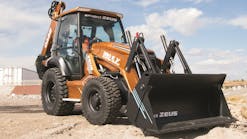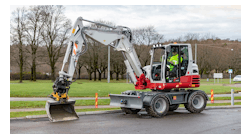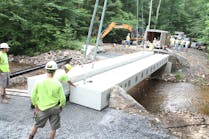When Takeuchi first introduced the compact excavator in 1971, some people scoffed and criticized that the machine was little more than a toy. Since then, the machine has become an integral part of the construction site, sometimes replacing other machines—and not only on general construction sites but in many other applications, too.
“Mini excavators are growing in use in demolition, waste and recycling, forestry, environmental, farm, and rail applications,” says Youssef Ben-Jemaa, product manager for compact excavators at JCB North America.
“Mini excavators are primarily digging machines but because of attachment availability, they are well-suited for landscaping, [and specialty agriculture such as] vineyards—because they can fit in between the rows, augering a post hole and then using a grapple to place the post, backfilling and grading and so much more,” says Joe Boufford, product marketing manager, New Holland Construction Equipment.
“One application that has surfaced in the last four to five years is running flail mowers,” says Tom Connor, excavator product specialist, Bobcat. “I see this in the municipalities and counties and townships for roadside maintenance. Mini excavators have tremendous reach and pinpoint control of cutting. For this reason, the machine has expanded into property maintenance. This is an application that we didn’t foresee for this machine six to eight years ago.”
Sometimes, mini excavators replace other machines that were once doing that work. For example, it has long competed with and outperformed the tractor-loader-backhoe (TLB) in many applications.
“Compact excavators have changed the way we excavate in general,” says Jeff Jacobsmeyer, Kubota product manager for excavators, wheel loaders, and TLBs. “The standard 25 years ago was a TLB, which was basically a wheeled tractor loader with a backhoe attached. Now the track machines can work in wetter conditions, with less ground pressure, resulting in less residual damage when performing repairs in existing landscapes. Also, tighter working conditions and the increased amount of hydraulic performance has made the TLB a bit of a dinosaur. There is still a market for TLB’s, however the compact excavator industry is continuing to grow as the TLB market is shrinking. The transportability of the compact excavator plays a role in its popularity as well. TLB’s have continued to get heavier as a rule. They have physically outgrown the jobs they used to perform years ago.”
Also, because mini excavators have increased in power over the years, they can now perform in road construction and utility applications that were once performed by standard-sized excavators. They can also be equipped with an extended boom for increased reach, making them even better competitors against larger excavators.
“A compact excavator is usually only limited by its dig depth and lifting capacity,” says Jacobsmeyer. “The modern machines are designed to dig every day, all day long, with an increasing emphasis on operator comfort and control. As a rule, projects requiring a trench 12-feet deep or less in depth are typically a good fit for compact excavators. It’s important to look at a job site as a whole and assess what size excavator you’ll need based on dig depth and lifting capacity.”
John Comrie, product manager, Volvo Construction Equipment North America, agrees that the number of attachments, especially customized attachments, has led to the success of mini excavators. “With customized attachments, you are limited only by your imagination when it comes to finding new uses for it, and the machine’s diversity is driving sales. More than 50,000 mini excavators are expected to be sold in North America in 2018. For the first time, mini excavator sales will outperform skid steer loader sales, making mini excavators the new Swiss Army knife.”
It’s not just machines that the mini excavator is replacing but people, too.
“Mini excavators under three tons are growing in popularity,” says Greg Worley, product application specialist for mini excavators, Caterpillar. “They are changing the way we work. In the past, we accepted a lot more manual work. Over the years, labor has become more expensive. Labor isn’t always readily available; people don’t want to work the same way they used to. Having a machine that can work similar to what used to be done by hand is useful. Compare working a sledgehammer and a pickaxe versus using a breaker on a small machine. Digging trenches, too. Once upon a time, you would have done it by hand; now, everybody turns to a machine to do it.”
Choosing a Mini Excavator
How do you choose a mini excavator? That question can yield more questions than answers.
“I get asked that question frequently,” says Connor. “Ask yourself: What have you done with a mini excavator or what would you have done with it? Are you renting one often and that is leading to a purchase decision? On what jobs do you foresee using this?”
“With a variety of sizes available, as well as conventional, short radius, and zero tail configurations, it can be confusing on which is best,” says Ed Brenton, brand marketing manager, CASE Construction Equipment. “The most important factor is for the job to get done safely with the right lifting capacities and the proper amount of reach. This will help identify which model is right and optimize the overall return on their investment.”
“Buying a mini excavator is similar to buying a work truck,” says Boufford. “You first look at performance and size, then price and look. Heavier machines typically have better performance. Make sure you compare apples to apples. Some machines come with features as standard, but they are an option on other machines.”
However, Dave Young, product marketing manager for John Deere Construction & Forestry and for Hitachi Construction Machinery – Americas, advises, “The first thing to consider when purchasing a mini excavator is how mobile are you going to be? How often are you moving it from point A to point B? Mobility is a big deal. For a lot of contractors, this is a prime concern. Choosing compact excavators under 10,000-pound net operating weight is the ideal choice. These compact excavators don’t require a CDL [commercial drivers license] to trailer, which is particularly attractive for those working in major cities or urbanized areas.”
Most every mini excavator product experts recommend considering the following criteria when purchasing a mini excavator: digging and reach requirements, machine size and transportation requirements, and attachment use—especially hydraulic power requirements.
“Evaluating the type of work you do, the attachments you utilize, job site and transportation variables, and creating a checklist that is specific to your needs will put you in a good position to correctly size a compact excavator that becomes an asset to your business, not a liability,” says Jay Quatro, field application and training specialist, Wacker Neuson.
“Think in terms of basic requirements such as dig depth, reach, and dump height and how these dimensions matter on a job site,” continues Quatro. “The types of attachments you want to run on an excavator are a major factor in properly sizing a machine. The flow and pressure requirements, as well as the number of hydraulic circuits you require, are also considerations in the sizing of a machine. Transportation capabilities are a factor, consider the capability of the trailering vehicle and trailer you plan on matching to your excavator. How confined or open are your typical job sites? Does a certain width create an issue in existing residential neighborhoods? Placing jersey barriers, digging French drains, running a plate compactor or an auger are all very different tasks with very different requirements, but the versatility of a mini excavator means they can all be accomplished by the same machine if you size it correctly. In addition to your current requirements, think to the future as well when sizing excavators. If you plan on expanding services offered, how does this impact your sizing requirements?”
“Do you have specific depth requirements?” asks Connor. “Are you laying pipe or foundations that have a constant depth? One of the most popular questions you hear at trade shows is what do you get for a 10-footer? Or, what do you got for a 12-footer? That is one of the main characteristics of the machine that people should think about. Also, if you need to routinely dig eight feet, don’t buy a compact excavator with a maximum dig depth of eight feet. You are going to want one with 30% more dig depth to gain any kind of efficiency.”
Connor continues, “What is that you are going to lift? Are you lifting and carrying? Lifting into position? I encounter a lot of folks who didn’t think about lift before they purchased their compact excavator. They end up using counterweights to achieve the job, but it would have been better if the customer and dealer had talked about lift before the purchase.”
Attachment use and the hydraulic flow that they may require will also play a large part in which mini excavator to buy or rent. “Are you going to bust concrete?” asks Connor. “Are you going to run a breaker? Do you need to use a grapple or a hydraulic plate compactor? Then you want a machine that can run a variety of attachments and can power the attachments that you want to use. Are you changing attachments often? What kind of quick-attach or power quick-attach do you want to use? This can make attachment changes that much easier.”
Also, consider the footprint of the machine. Will it fit in the workspaces that you have in mind? A few inches can mean the difference between whether a machine fits through a passageway.
Digging with a Gehl M08
On the Small End
Usually, in applications that require small mini excavators—in the 1- to 2-ton range—the only alternative for a mini excavator is manual labor.
“Smaller compact excavators are ideal for municipality work, drainage pipes, sewage pipes, water pipes, and road construction within a city,” says Young. “These job sites typically require operators to work within tight confines. John Deere offers compact excavators with design features like reduced-tail-swing and variable-width undercarriage to help operators work in tight quarters with ease.”
“The current smallest compact excavator Kubota manufactures is the K008-3T4, which is designed for contractors who work in space-restricted areas in a wide range of construction and building work,” says Jacobsmeyer. “The variable adjustable track on the K008-3T4 makes it possible to adjust the machine width down to two feet, four inches, allowing access through many common doorways. The foldable ROPS will drop to an overall height of five feet, 11 inches, allowing for access in height restricted areas. Moving through backyard gates and working under existing structures, such as an attached deck, are perfect examples of where the K008-3T4 is used. For projects like a backyard remodel to plumbing repairs, the K008-3T4 is a great choice.”
“In some really large projects, mini excavators are lowered into the holes dug by large excavators to square out the hole,” says Connor. “Another purpose I see is refurbishment. Take an old factory and re-proportion the floors, break out concrete, load into hoppers, and prepare the new floor.”
“Indoor demolition is the primary application for the Wacker Neuson Dual Power 803 excavator,” says Quatro. “Because the Dual Power 803 runs on an electric powered hydraulic motor—and is a zero-emissions solution—it’s perfect for indoor applications. We see a high demand for zero emissions work in hospitals, schools, food service, and food production applications. The ability of the 803 running on the HPU [hyraulic power unit] power pack with a breaker attachment makes indoor utility work and floor repair extremely efficient.”
Caterpillar also has a dual power machine. “Customers would like dual power on more models and larger models,” says Worley. “But the technology isn’t there yet, so right now, it’s restricted to the one-ton size machine.”
IHI Compact Excavator Sales has two mini excavators that are fully electric.
Another feature that is becoming more common among small mini excavators is a foldable canopy. The ability to fold the canopy is useful when putting the machine through doors or any low overhang situation.
On the Big End
Mini excavators are ideal for getting into tight spaces where larger excavators can’t. They can handle a variety of jobs and, on the larger end, they can do some of the same work. Some manufacturers classify their machines using 6 metric tons as the boundary between mini excavators and standard excavators, while other manufacturers use 8 metric tons.
“Large mini excavators are going to be trenching for communication lines, digging around obstacles and getting into the tight areas that the big excavators can’t,” says Brenton. “They definitely make the most sense when you can’t get your larger machine in or around the job site you’re going to be working on.”
“Contractors use larger mini excavators for trenching, backfilling, sewer work, demolition, lifting, and loading,” says Mike Watt, excavator product manager, LiuGong. “The larger machines have the hydraulic power and reach needed for these applications.”
“The Hitachi 6-metric-ton machine is very popular in road construction,” says Young. “Not the super loop that goes around a city that requires really large machinery, but a four-lane municipal road—our six-metric-ton machine has a very fair bucket size and digging capacity and depth. It’s good for water lines and sewage lines, basically everything that goes along with a municipal project. As well, if you equip it with rubber tracks, and many contractors do, you can cross a highway that is prepared for asphalt without disturbing the subgrade.”
The larger CASE C Series mini excavators are available in zero tail swing, short-radius or conventional configurations, depending on the needs and specifications of the equipment owner. “There is also a long-arm option on certain models that includes a counterweight—this is ideal when an operator needs to get more work done without having to reposition the machine,” says Brenton. “They also feature an adjustable boom with the ability to offset left or right to work closer to buildings and obstacles—this is especially helpful when digging along foundations in tight urban areas, as well as working along roadsides and other high-traffic areas.”
Late last year, Volvo Construction Equipment North America launched the EW60, which is a rare example of a wheeled mini excavator. It weighs 12,000 pounds (5.5 metric tons) and travels at 19 miles per hour. “There are areas where the wheel excavator has an advantage: over tack areas, urban areas, replacing water/gas lines, maneuvering around the city center, and no need for additional transport,” says Comrie.
Caterpillar manufactures an 8-metric-ton class mini excavator. “It is a powerful, powerful machine,” says Worley. “It is a compact radius machine that is easy to transport with a regular truck and trailer. You can get the truck and trailer into a subdivision much easier than you can the transport equipment needed to haul a larger machine. Because of the machine’s power, size, and ability to perform a broad range of tasks, it has become a very popular rental item.”
Rental
Rental companies purchase a lot of compact excavators, but they have to not only think of what they want in a mini excavator but also what their customers want in a mini excavator. Sometimes those wants conflict. Contractors may sometimes want high horsepower, but rental companies often prefer zero-tail-swing machines, so they don’t get returned banged up.
“Rental companies are looking for two things: maximizing ROI [return on investment] and high utilization,” says Quattro. “Our EZ28 and EZ38 zero tail excavators are very popular in rental fleets because of this. They fit into the most popular size in the mini excavator market, which is the three- to four-metric-ton size range. Being zero-tail machines allows them to be used in a wider variety of applications when compared to a conventional tail excavator. Another big consideration for rental companies is resale value. Adding in unique features, like the Vertical Dig System (VDS) and our exceptional warranty, make the EZ28 and EZ38 no-brainers when it comes to the rental market.”
“The new Gehl M08 and existing Z17, Z27, and Z35 are excellent smaller excavators just right for the multitude of jobs in rental,” says Kelly Moore, product and training specialist, Manitou North America. “Rental companies and customers want very reliable, easy to operate, and easy to maintain excavators, as found in the Gehl compact excavator range.”
“Rental companies look at utilization and total cost of ownership,” says Connor. “They routinely look at attachment options. Which attachments is this machine capable of operating, and which attachments are provided by the OEM [original equipment manufacturer]. Rental companies are more diverse than they used to be. Years ago, rental companies may have offered two sizes of buckets; that’s it. Now, attachments are critical for increasing utilization. The second thing is the total cost of ownership. How much is it going to cost me to purchase the machine, to operate and maintain the machine, and what is it’s expected resale value?”
“The rental market is pushing simplicity,” says Watt. “Renters usually don’t need all the bells and whistles that an owner-operator does. Rental companies want low fuel consumption, stability, a strong boom design, and easy maintenance—no field technicians with laptops.”
JCB agrees with this approach. They manufacture a 45Z, which is a rental ready machine featuring basic specs, a canopy only option and a dozer blade. It’s a variation of the company’s popular 48Z, which gets sold through their dealer network, but with limited capabilities and options compared to the 48Z.
“If rental companies cater largely to homeowners and the DIY (do it yourself) crowd, one of the biggest concerns for the rental company is the delivery of the machine, so smaller is often better,” says Connor. “Three-ton machines are popular in rental shops. Rental companies whose customer base is the long-term renters, stock machines up to eight tons. Contractors who are looking for a machine for a month or two tend to rent machines in the five- to eight-metric-ton range. Although the volume is at three-metric tons and smaller, the eight-metric-ton class is growing. If you had said 10 years ago that you were going to sell an eight-metric-ton machine into the rental market, people would have thought you were crazy. Now, the rental market is more diverse.”









